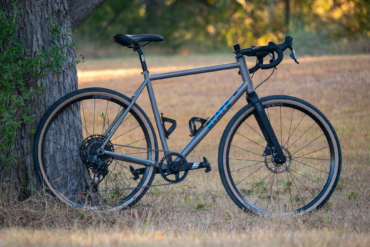Recyclable carbon wheels have been around for a few years. However, until HUNT’s H-Cyclo, they differed in construction and physical properties relative to traditional carbon bicycle wheels, frames, and forks.
HUNT Bike Wheel has seemingly solved the Rubik’s cube, allowing the brand to recycle traditional thermoset carbon wheels back into materials that can form other carbon parts. The British brand flexes this new technology with two gravel-oriented models, the HUNT 40 Carbon Gravel Race H_Cyclo and the HUNT Carbon Gravel Dynamo H_Cyclo. The latter has a generator in the front hub for powering lights.
Thermoset vs. Thermoplastic Carbon Bike Components

To understand why HUNT H_Cyclo is a significant development in cycling, a little backstory is necessary.
Traditional thermoset carbon construction uses “prepreg” carbon fabrics. Carbon fiber producers pre-impregnate fabrics with uncured epoxy resin. Wheel manufacturers cut and lay these pieces according to a complex layup schedule into molds. Baking these molds in ovens cures the epoxy resin, turning the flexible fabric into the incredibly stiff, strong, and light carbon parts that cyclists appreciate.
Before HUNT H_Cyclo, recyclable wheels utilized long-chain polymers (thermoplastic) instead of epoxy resin as the bonding agent for the carbon fiber. Material brand FusionFiber supplies names like Revel Bikes, Forge + Bond, Chris King, and others for use in recyclable wheels. FusionFiber claims its thermoplastic material has several advantages: less energy to produce, less finish work, zero toxins, and automated production steps, among others.

In my experience, the physical properties of FusionFiber wheels also differ from thermoset models. Thermoplastic wheels perceptibly feel “softer,” damping vibrations and the jolts from square edges more effectively. But this isn’t necessarily desirable in all cases. Thermoset carbon has the stiffness that cyclists demand, especially in racing.
Thermoset carbon manufacturing methods are the most mature; manufacturers in various industries have worked out most of the kinks at this point. And this proven method generally produces the highest strength-to-weight ratios in the end products, according to HUNT.

How HUNT’s H_Cyclo Bike Wheels Crack the Code

HUNT borrowed technology from the carbon wind turbine blade industry, leveraging chemical reactions to revert the epoxy resin to its original form, freeing up the carbon fiber. Both of these can then be used again to produce carbon fiber products.
HUNT produces its H_Cyclo wheels using the time-tested thermoset method the cycling industry has used for decades. Instead of using heat to reduce the end product, HUNT employs a chemical solution called CleaVER. This, combined with agitation and heat, separates the resin from the carbon for reuse.
Amazingly, the epoxy resin can be reused up to 20 times. Additionally, HUNT can reprocess the CleaVER solution for continued use.
HUNT explained to me that, similar to thermoplastics, the original wheel has to be somewhat broken down before resin extraction. This means the products made from the extracted carbon must be smaller.
HUNT suggested carbon fiber soles for cycling shoes, components like stems and seatposts, computer mounts, and, again, tire levers are possible output products. This is the same issue with thermoplastic recyclable wheels.
How Do I Get Some HUNT H_Cyclo Wheels of My Own?

Both the 40 Carbon Gravel Race and 40 Carbon Gravel Dynamo wheelsets are available now for an MSRP of $1,399 and $1,849, respectively. And at the end of the wheels’ life cycle, HUNT will cover all the costs related to collection and recycling, even if the wheels meet their demise in a crash. The wheels come with HUNT’s standard 3-year warranty against material or workmanship defects.
The two H_Cyclo wheels join HUNT’s “Sustain Phase One” project, which aims to improve sustainability across all its products. Current wheels within this lineup include carbon versions that use 10% recycled carbon fiber and 75% recycled aluminum, among other efforts. HUNT also sells lightly used wheelsets at a savings of up to 50% in its RE:NEW program.
HUNT Bike Wheels slated a set of H_Cyclo wheels for GearJunkie, and we will report back as soon as possible.








